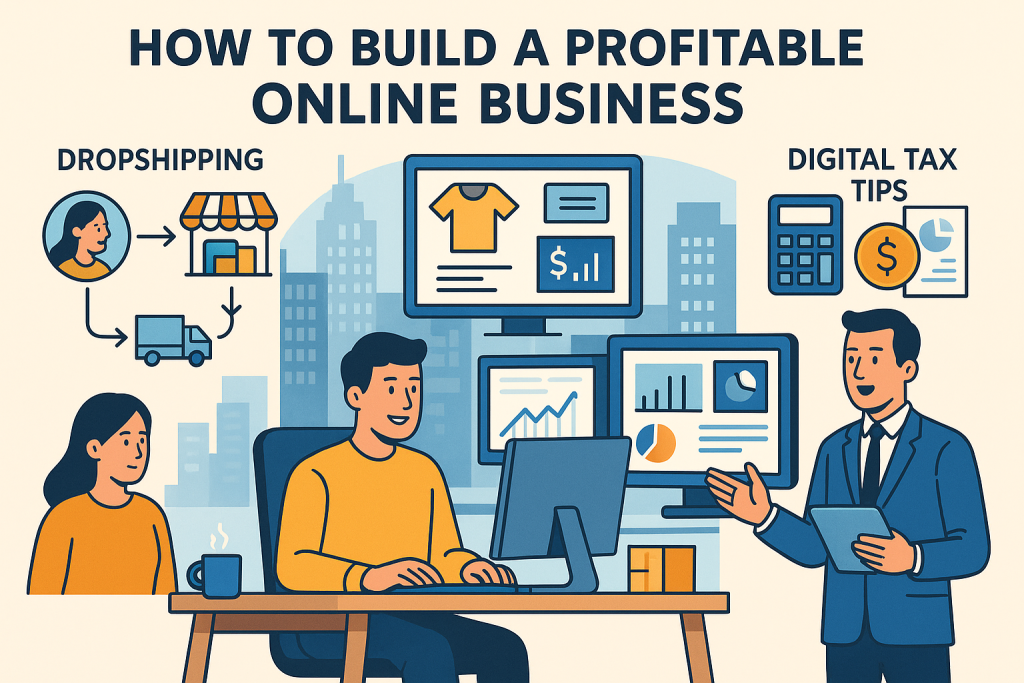
Starting an online business has never been easier—or more profitable. In 2025, with the rise of automation, global marketplaces, and low-overhead business models, launching an e-commerce store can be one of the smartest ways to achieve financial freedom.
But like any business, success requires planning, tools, and knowledge of how to optimize operations—especially with increasing digital taxation and market competition.
In this guide, you’ll learn how to build a profitable online store, explore dropshipping, and navigate the latest updates in digital tax regulations.
💡 Why Start an Online Business in 2025?
- Low startup costs: No need for a physical storefront or large inventory.
- Scalability: Reach global customers 24/7.
- Automation tools: Manage marketing, fulfillment, and analytics with ease.
- Passive income potential: Once set up, many processes can run hands-free.
💬 Keywords: start online store 2025, passive income from ecommerce
🛍️ E-commerce Models: Which One Is Right for You?
There are several types of online businesses. Choosing the right one depends on your budget, skills, and goals.
1. Dropshipping
You sell products online, but a third-party supplier handles inventory and shipping.
- Pros: Low risk, no warehousing
- Cons: Lower margins, quality control issues
💬 Keyword: best dropshipping suppliers 2025
2. Print on Demand (POD)
Sell custom-designed products (shirts, mugs, phone cases) with no upfront inventory.
- Pros: Creative freedom, no inventory
- Cons: Slower shipping, niche competition
3. Private Label or White Label
Buy generic products and sell under your own brand.
- Pros: Brand building, better margins
- Cons: Requires investment in inventory and packaging
4. Digital Products
Sell eBooks, courses, templates, music, or digital art.
- Pros: No shipping, 100% profit margins
- Cons: Requires audience trust, harder to scale initially
💬 Keyword: most profitable ecommerce niches 2025
📈 How to Ensure Online Store Profitability
Even in a saturated market, profitability is possible with the right strategies.
1. Find a Profitable Niche
Look for products with:
- High demand + low competition
- Passionate audiences (e.g., pet lovers, fitness)
- Recurring need or high perceived value
Use tools like Google Trends, Ubersuggest, and SEMrush to validate your niche.
2. Optimize for Conversion
- Use a fast, mobile-optimized website (Shopify, WooCommerce)
- Clear CTAs, product reviews, trust badges
- High-quality product images and videos
- Offer money-back guarantees
💬 Keyword: ecommerce conversion rate optimization
3. Maximize Lifetime Customer Value (LCV)
- Upsells and cross-sells
- Email marketing funnels
- Loyalty and referral programs
🚚 What You Need to Know About Dropshipping in 2025
Dropshipping continues to grow, but customer expectations are higher.
Key Tips for Success:
- Use U.S. or EU-based suppliers for faster shipping
- Partner with platforms like Spocket or Zendrop for vetted suppliers
- Focus on branding: customize packaging and offer excellent support
💬 Keyword: fastest dropshipping suppliers USA
🧾 Understanding Digital Taxes in E-commerce
Taxes are evolving fast in the world of online business. In 2025, digital tax laws are stricter and more widespread.
1. Sales Tax in the U.S.
Most states now require sales tax collection if you meet nexus thresholds—either physical or economic.
💬 Keyword: ecommerce sales tax compliance
2. EU VAT (Value-Added Tax)
If you sell digital products in Europe, you’re required to charge VAT based on the buyer’s location.
3. GST and International Taxes
Countries like Canada, Australia, and India have their own GST/VAT laws for online sales.
How to Stay Compliant:
- Use automated tools like TaxJar, Quaderno, or Avalara
- Track thresholds in different states and countries
- Clearly display tax amounts at checkout
💬 Keyword: digital product VAT software
🛠️ Essential Tools for Running a Successful Online Business
Here are tools that can automate and scale your business:
E-commerce Platforms:
- Shopify – Best all-in-one store builder
- WooCommerce – Flexible and WordPress-based
- BigCommerce – Built-in multi-channel selling
Marketing & SEO:
- Klaviyo – Advanced email marketing
- SEMRush – Keyword research and competitor analysis
- Canva – Design product images and ads
Analytics & Conversion:
- Hotjar – See how users interact with your site
- Google Analytics 4 – Track key metrics and sales funnels
💼 Bonus: Business Structure & Taxes for Entrepreneurs
- Register as an LLC or sole proprietor to protect yourself legally.
- Consider using QuickBooks, FreshBooks, or Wave for bookkeeping and expense tracking.
- Pay quarterly estimated taxes if you’re profitable.
💬 Keyword: LLC vs sole proprietorship ecommerce
🏁 Final Thoughts: Start Strong, Scale Smart
The e-commerce industry continues to offer massive opportunities in 2025—but only to those who are prepared. With the right business model, tech stack, and tax strategy, you can create a profitable and sustainable online business.
✅ Choose a niche based on data
✅ Invest in branding and customer experience
✅ Automate your backend processes
✅ Stay compliant with international tax regulations
Now is the time to turn your idea into a profitable venture.